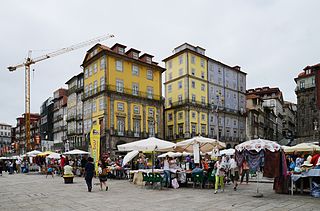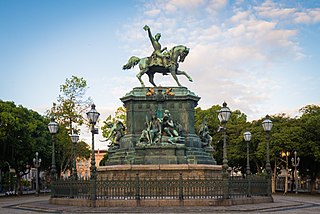
The monument to King Pedro IV (Portuguese : Monumento a D. Pedro IV) is located in the Liberdade Square in Porto, Portugal.

The monument to King Pedro IV (Portuguese : Monumento a D. Pedro IV) is located in the Liberdade Square in Porto, Portugal.
The bronze statue on a top of a high column (10 meters) of lioz stone was made of 5 tons of bronze by Célestin Anatole Calmels (sculpture) and Joaquim da Costa Lima (architecture). The column features two-sided pedestal stands which depict the delivery of Pedro’s heart to the representatives of Porto and landing at Mindelo where Pedro IV gave the flag to Tomás de Melo Breyner. These two low-reliefs were originally made of Carrara marble, and they have been replaced with bronze duplicates for protection purposes. The coats of arms of Bragança and Porto have been depicted on the front and back sides of the column and surrounded with oak and bay leaves. [1] [2]
The statue was fused in Belgium and it describes Pedro (in a military uniform on horseback) presenting the constitutional charter (on his right hand) to Porto. [1] The monument was inaugurated in October 1866. It has been classified as Property of Public Interest since 1982. [1] [2]

The Liberal Wars, also known as the War of the Two Brothers and the Portuguese Civil War, was a war between liberal constitutionalists and conservative traditionalists in Portugal over royal succession that lasted from 1828 to 1834. Embroiled parties included the Kingdom of Portugal, Portuguese rebels, the United Kingdom, France, the Catholic Church, and Spain.

Wellington's Column, or the Waterloo Memorial, is a monument to the Duke of Wellington standing on the corner of William Brown Street and Lime Street, Liverpool, Merseyside, England. It is recorded in the National Heritage List for England as a designated Grade II* listed building.

The Alcobaça Monastery or Alcobasa Monastery is a Catholic monastic complex located in the town of Alcobaça, in central Portugal, 120 km (75 mi) north of Lisbon and 110 km (68 mi) south of Coimbra.

Mindelo is a civil parish in Vila do Conde Municipality, along the Green Coast in continental Portugal. Situated 21 km northwest of Porto, it is part of the Greater Metropolitan Area of Porto. The population in 2021 was 3,988, in an area of 5.74 km2.

The Columbus Monument is a 60 m (197 ft) tall monument to Christopher Columbus at the lower end of La Rambla, Barcelona, Catalonia, Spain. It was constructed for the Exposición Universal de Barcelona (1888) in honor of Columbus' first voyage to the Americas. The monument serves as a reminder that Christopher Columbus reported to Queen Isabella I and King Ferdinand V in Barcelona after his first trip to the new continent.

Batalha Square is a historical public square located in the city of Porto, in Portugal.

The Ribeira Square is a historical square in Porto, Portugal. It is included in the historical centre of the city, designated World Heritage by UNESCO.

Liberdade Square is a square in the city of Porto, Portugal. It is located in Santo Ildefonso parish, in the lower town (Baixa) area. The square is continuous on its north side with the Avenida dos Aliados, an important avenue of the city.

The Monument to Alfonso XII is located in Buen Retiro Park, Madrid, Spain. The monument is situated on the east edge of an artificial lake near the center of the park.

Richard Coeur de Lion is a Grade II listed equestrian statue of the 12th-century English monarch Richard I, also known as Richard the Lionheart, who reigned from 1189 to 1199. It stands on a granite pedestal in Old Palace Yard outside the Palace of Westminster in London, facing south towards the entrance to the House of Lords. It was created by Baron Carlo Marochetti, an Italian sculptor whose works were popular with European royalty and the nobility, though often less well regarded by critics and the artistic establishment. The statue was first produced in clay and displayed at The Great Exhibition in 1851, where it was located outside the west entrance to the Crystal Palace. It was well received at the time and two years later Queen Victoria and Prince Albert headed a list of illustrious subscribers to a fund that aimed to raise money for the casting of the statue in bronze.

The Column of Pedro IV is a monument to King Peter IV of Portugal and the Algarves, located in the centre of Rossio Square in Lisbon, Portugal. The monument was erected in 1870.

The Camões Monument is a monument located in Luís de Camões Square in the Chiado neighbourhood of Lisbon, Portugal. The monument comprises a tall bronze statue of Luís de Camões, the national poet, on a lioz limestone pillar surrounded by eight smaller statues of leading figures of Portuguese culture and literature in the Age of Discoveries: Fernão Lopes, Pedro Nunes, Gomes Eanes de Zurara, João de Barros, Fernão Lopes de Castanheda, Vasco Mouzinho de Quevedo, Jerónimo Corte-Real, and Francisco de Sá de Meneses.

Marqués del Duero, also known as Monumento al Marqués del Duero, is an instance of public art located in Madrid, Spain. Erected on the centre of the Plaza del Doctor Marañón, the monument consists of a bronze equestrian statue representing Manuel Gutiérrez de la Concha e Irigoyen—a general who stood out in the fight against Carlism—on a stone pedestal decorated with two reliefs.

The Monument to Columbus is an instance of public art in Salamanca, Spain. The monument, dedicated to Christopher Columbus, is erected on the centre of the namesake plaza.

The monument to Maria Christina of Bourbon is an instance of public art in Madrid, Spain. Designed by Mariano Benlliure and consisting of a bronze statue of the aforementioned queen consort and regent of Spain and a stone pedestal with additional sculptural elements, the monument lies in front of the Casón del Buen Retiro.

The Monument to Count Ansúrez is an instance of public art in Valladolid, Spain. Located at the Plaza Mayor, it consists of a bronze statue of Count Pedro Ansúrez, founder of the town of Valladolid in the 11th century, topping off a stone pedestal with additional sculptural elements.

The equestrian statue of Pedro I is located in Tiradentes Square, in the city center of Rio de Janeiro, in the homonymous state, Brazil. It is a national historical heritage, listed by the National Institute of Historic and Artistic Heritage (IPHAN), since 4 March 1999. It is also a Rio de Janeiro state cultural heritage, registered by the Instituto Estadual do Patrimônio Cultural (INEPAC), since 26 September 1978.

The Saint Anthony Monument is a monument in Lisbon, Portugal, located at the Alvalade Square, within the civil parish of Alvalade. It consists of a bronze statue on a pedestal formed by 4 marble blocks. The statue depicts Anthony of Padua, a 12th- and 13th-century Roman Catholic priest, who is the official patron saint of the city of Lisbon. The monument had been created by architect Carlos Antero Ferreira and sculptor António Duarte, and unveiled on 4 October 1972.

The Monument to the Duke of Caxias is a platinum bronze statue on a granite pedestal depicting the battles of the Duke of Caxias. Located in the city of São Paulo, the monument is 48 meters high and is the second largest equestrian memorial in the world.

The Monument to the Fallen of the Great War, also known as the Monument to the Combatants of the Great War, is a monument in Lisbon, Portugal, within the civil parish of Santo António, at Liberty Avenue, near the intersection with Salitre Street. It is dedicated to the soldiers of the Portuguese Army, that died during the First World War. The monument was designed by Guilherme Rebelo de Andrade, Carlos Rebello de Andrade, and Maximiano Alves, and unveiled on 22 November 1931.